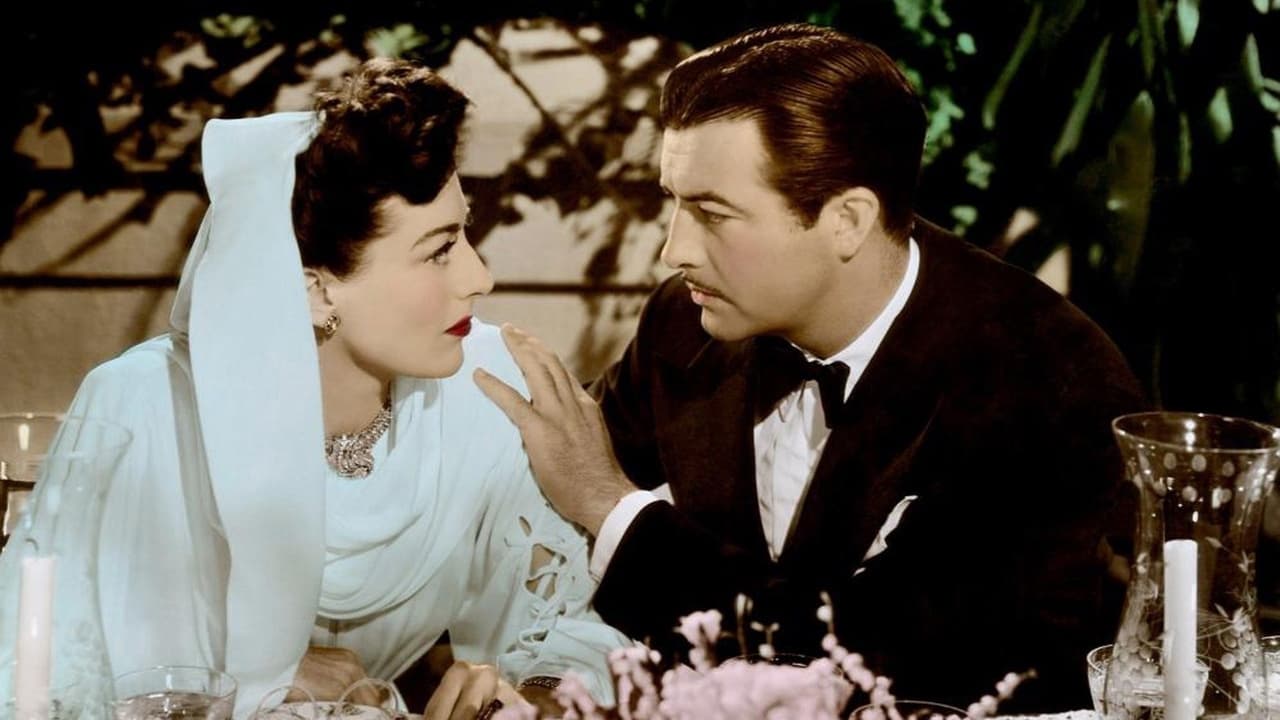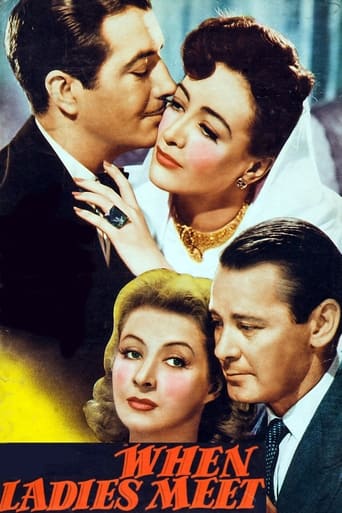

Waste of time
... View MoreA brilliant film that helped define a genre
... View MoreIt isn't all that great, actually. Really cheesy and very predicable of how certain scenes are gonna turn play out. However, I guess that's the charm of it all, because I would consider this one of my guilty pleasures.
... View MoreEasily the biggest piece of Right wing non sense propaganda I ever saw.
... View More. . . (that would be A WOMAN'S FACE), this movie has the novelty of being the only pairing between the old face of MGM--Crawford--and the Roaring Lion's new visage, the future Mrs. Miniver herself, Greer Garson. Crawford's tyrannical ways had worn out her welcome at Tara, and Garson was several years away from ruining her own Reign on the Mane by wedding "Mrs. Miniver's" son in Hollywood's version of reality. However, when Joan and Greer's characters finally get to have their wildly-anticipated heart-to-heart toward the end of WHEN LADIES MEET, there is no talk of wire hangers or virtual incest. Instead, they have a highly contrived conversation about a "hypothetical" love triangle that the viewers already know is Hyper-Actual. Herbert Marshall's performance as the man in their middle is so smarmy that it's hard to imagine the women in a theater audience NOT loudly hissing collectively whenever he's on-screen. On the other hand, Robert Taylor as a thinner, wise-cracking good guy with a mustache is so similar to William Powell or Don Ameche's usual performances, it's surprising that those three were not born triplets in real life.
... View More"When Ladies Meet" is the story of a married couple, a lady author and a charming single journalist. Joan Crawford, the author, considers herself a "modern woman" freed from tiresome conventions and moral imperatives. Despite the movie's 1941 date, the author's relativistic attitude toward marriage and fidelity would be right at home in today's left-wing intellectual circles. Her gradual evolution towards a different attitude is the meat of the movie. Mirroring the situation in her book is the situation of the married couple, Greer Garson and Herbert Marshall. The fourth member of the group is Robert Taylor as a journalist whose surface gaiety hides a serious moral foundation.The four actors make the movie much better than the script. Garson and Crawford strike sparks off each other in every scene they share. Herbert Marshall is suitably smooth and sleazy. But it's Robert Taylor in a role involving physical comedy whose work is the most impressive. As it turns out, he is the person most grounded in reality--and the hidden hand behind everything.Everything has the expected MGM gloss--extravagant costumes, beautiful sets, excellent photography. Highly recommended.
... View MoreI had a bit of hard time sticking with this movie to the end. I don't normally force myself to watch movies that are lugubrious, but I was curious on several fronts. Firstly, this movie has been out of release, and only recently available through Warner Archives/ Classic Flix, so I'm one of those completists curious to see it. I find as time goes by, that the artifice of the MGM glossy films circa 1940 to 1945 done in this exact high-style - lavish sets and costumes, arch dialogue, drawing-room sensibilities - are hard to take - and I'm someone who is forgiving of, and loves, old movies! I'm fascinated by the MGM pix of this period because of how many are quite bad - and while "Metro" was riding the wave of its success, these films were the beginning of their undoing, as well. This was generally a really bad period for Joan Crawford, as we all know, saddled with mostly bad material, and hampered by her aspiration to be "a great lady of cinema" a la Norma Shearer. Her personal upward mobility from humble roots tainted her work, because she had a personal need to assume the drawing- room enunciation and lady-of-the-manor mannerisms, both of which are so phony in this film - and a blatant contradiction to her natural street-smart roots. I find Joan painfully bad in this movie - so needing to be who she's not. As I watched, I ached for her to shake off her personal psychodrama, as she would 4 years later when she was pushed to authenticity with Mildred Pierce - probably the first time on-camera that there was real grit and edge in her performance, that something was scraped away and you could feel her rawness. The catalyst, for the breakthrough, as we know, was that her artistic and professional career were in jeopardy. As for Greer Garson, her natural charisma, grace and screen presence are quite astonishing - she just draws your eye, and radiates. It's so easy to see why she became a star so quickly, and why audiences (and Louis B. Mayer) loved her. Not the best actress, but very natural in front of a camera, and luminous. I am in conflict with other writers here about Herbert Marshall, who I have always been attracted to for his otherworldly calm and inner sense of goodness. I can see the attraction, even though he isn't overtly dazzling, like Robert Taylor. I find Taylor, like Crawford, is a "movie star" more than actor, and you see him trying to rise to the occasion here in a persona and style of acting that is not in sync with who he is. As I watched, I speculated that this role might have been written for Clark Gable circa 1941 - mischievous, winking, self-aware, dashing, irrascible - but Taylor's performance was forced, a carbon copy of Gable or Robert Montgomery, or even Ray Milland (though he was actually better than I would have expected.) I also found Spring Byington a copy of Alice Brady and Billie Burke - not bad, but a bit forced, like Robert Taylor and Joan Crawford. In fact, I could imagine this script written for Gable, Claudette Colbert and other stars - but they cast who was available. As for the costumes, they weren't as over the top as some MGM films, but, as someone else commented, that ludicrous gardening outfit that Joan Crawford wears - an enormous picture hat, a padded-shoulder dress with gingham inserts that carries through to a matching gingham trim on the hat, and the same fabrics on the elbow- length gardening gloves - is fabulously preposterous, and an embodiment of the total disconnect from reality that infuses this movie. As for the plot, it's dated drawing-room fare with a single mise-en-scene that worked for me -- when the two "ladies" finally realize their respective identities. There was genuine tension and emotion, and a certain authenticity in tone and feelings. Other than that, MGM cake frosting.
... View MoreI bought this movie starring Joan Crawford, Greer Garson and Robert Taylor and the earlier version starring Myrna Loy, Robert Montgomery and Ann Harding. I have to say they should have used Myrna Loy rather than Joan Crawford in the new version, because Greer Garson stole the movie. Joan Crawford spent most of the earlier part of the movie fumbling with her exotic gown, in an attempt to draw attention to the gown and the person wearing it, which of course is Joan Crawford.If you get past Joan Crawford non-acting, and Herbert Marshall stiffness, then the movie is rather funny. Greer Garson and Robert Taylor carry this movie, if is rather funny, but I can't understand why any woman would prefer Herbert Marshall over the suave and good looking Robert Taylor. You ladies reading this review, please explain that to me. Even though I like this movie, I think the acting in earlier version was better especially Myrna Loy's acting. She is a better actress than Joan Crawford, at least in these two similar movies. This movie is a two woman in love with the same man Herbert Marshall (Rogers Woodruff), Greer Garson (Clare) is his wife, and Joan Crawford (Mary) is his lover. Why would these two beautiful women love this stiff man, I don't know, especially when they could both have Robert Taylor. Robert Taylor (Jimmy) is Joan Crawford's (Mary) old boyfriend, who realized that Herbert Marshall (Clare's husband, Rogers Woodruff) is not in love with Mary, he just wanted to sleep with her, he warns Mary, but she don't believe him, so he introduce Mary to Clare without telling Mary that Clare is Rogers Woodruf's wife, whom he Rogers Woodruff still loves. Once Mary finds out that Rogers Woodruff was lying to her, and only using her, she stated she is ashamed of her life and ashamed for sleeping with him, she also realized that the person who really loves her and really cares for her is Jimmy, you guess it. Jimmy finally gets her girlfriend back, who ends up being his wife, who will give him the six kids he wants, or maybe only two.
... View More